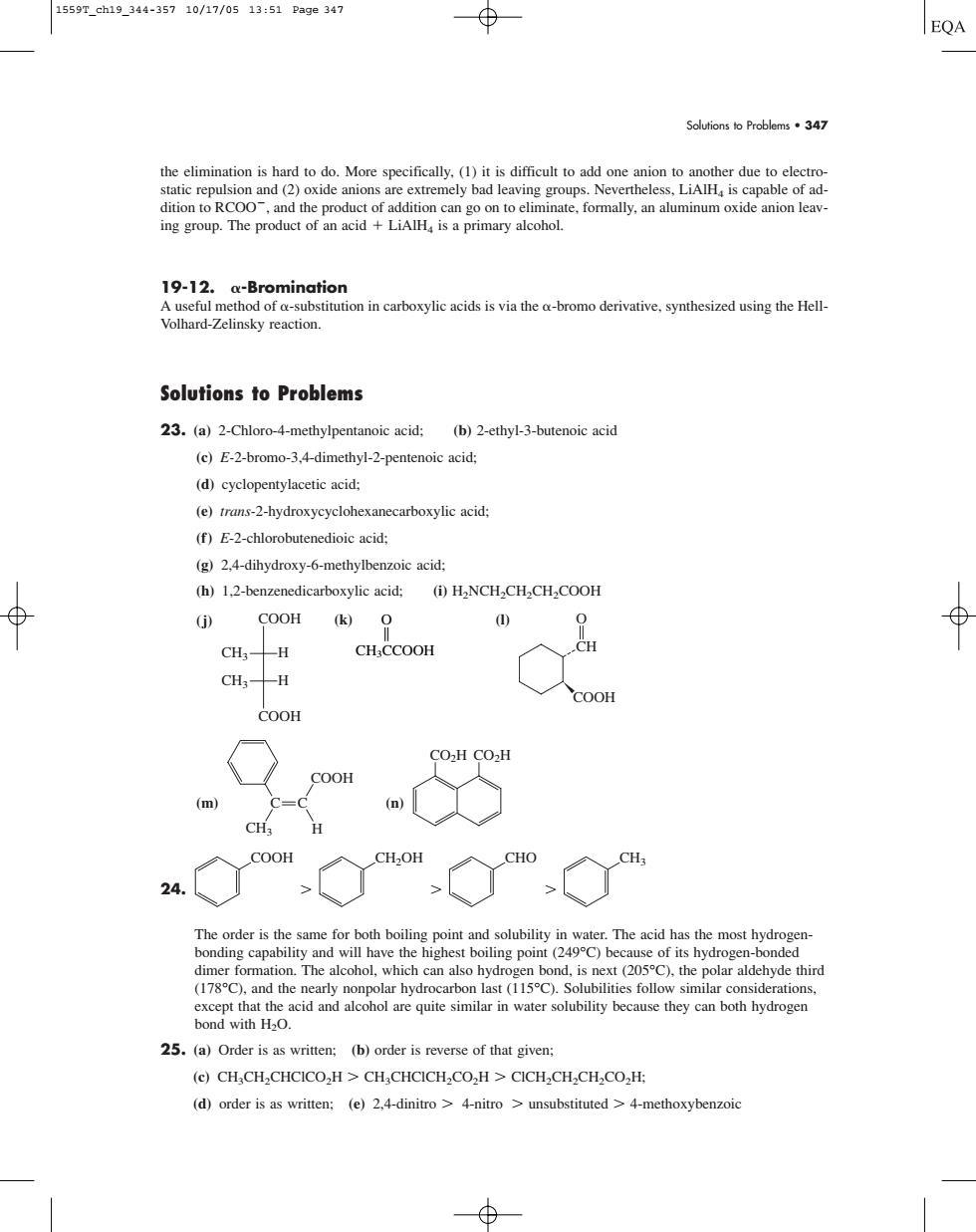正在加载图片...

1559T_ch19_344-35710/17/0513:51Pa9e347 ⊕ EQA Solutions to Problems.347 nother due to electro an派o,或itcul toe可 bad leaving groups Nevertheless.LiAH s capable ofad cohol. te.formally.n aluminum oxide anion leav 19-12.a-Bromination A useful method of -substitution in carboxylic acids is via the -bromo derivative.synthesized using the Hell- Volhard-Zelinsky reaction. Solutions to Problems 23.(a)2-Chloro-4-methylpentanoic acid:(b)2-ethyl-3-butenoic acid (e)E-2-bromo-3.4-dimethyl-2-pentenoic acid (d)cyclopentylacetic acid: (e)trans-2-hydroxycyclohexanccarboxylic acid: (f)E-2-chlorobutenedioic acid: (g)2.4-dihydroxy-6-methylbenzoic acid: (h)1.2-benzenedicarboxylic acid:(i) COOH (k)O H CH.CCOOH CH CH3- -H COOH COOH CO2H CO2H COOH CH COOH CH2OH CHO 24. > The order is the same for both boiling point and solubility in water.The acid has the most hydrogen- bonding capability and will have the highest boiling point (249C)because of its hydrogen-bonde d th quemnater becase they canbyo 25.(a)Order is as written:(b)order is reverse of that given: (c)CHCH,CHCICO,H>CH CHCICH CO,H>CICH CH,CH,CO,H: (d)order is as written:(e)2.4-dinitro>4-nitro>unsubstituted>4-methoxybenzoic Solutions to Problems • 347 the elimination is hard to do. More specifically, (1) it is difficult to add one anion to another due to electrostatic repulsion and (2) oxide anions are extremely bad leaving groups. Nevertheless, LiAlH4 is capable of addition to RCOO, and the product of addition can go on to eliminate, formally, an aluminum oxide anion leaving group. The product of an acid LiAlH4 is a primary alcohol. 19-12. -Bromination A useful method of -substitution in carboxylic acids is via the -bromo derivative, synthesized using the HellVolhard-Zelinsky reaction. Solutions to Problems 23. (a) 2-Chloro-4-methylpentanoic acid; (b) 2-ethyl-3-butenoic acid (c) E-2-bromo-3,4-dimethyl-2-pentenoic acid; (d) cyclopentylacetic acid; (e) trans-2-hydroxycyclohexanecarboxylic acid; (f) E-2-chlorobutenedioic acid; (g) 2,4-dihydroxy-6-methylbenzoic acid; (h) 1,2-benzenedicarboxylic acid; (i) H2NCH2CH2CH2COOH (j) (k) (l) (m) (n) 24. The order is the same for both boiling point and solubility in water. The acid has the most hydrogenbonding capability and will have the highest boiling point (249°C) because of its hydrogen-bonded dimer formation. The alcohol, which can also hydrogen bond, is next (205°C), the polar aldehyde third (178°C), and the nearly nonpolar hydrocarbon last (115°C). Solubilities follow similar considerations, except that the acid and alcohol are quite similar in water solubility because they can both hydrogen bond with H2O. 25. (a) Order is as written; (b) order is reverse of that given; (c) CH3CH2CHClCO2H CH3CHClCH2CO2H ClCH2CH2CH2CO2H; (d) order is as written; (e) 2,4-dinitro 4-nitro unsubstituted 4-methoxybenzoic COOH CH2OH CHO CH3 CO2H CO2H C COOH H C CH3 COOH CH O H COOH COOH CH3 CH3 H O B CH3CCOOH 1559T_ch19_344-357 10/17/05 13:51 Page 347�